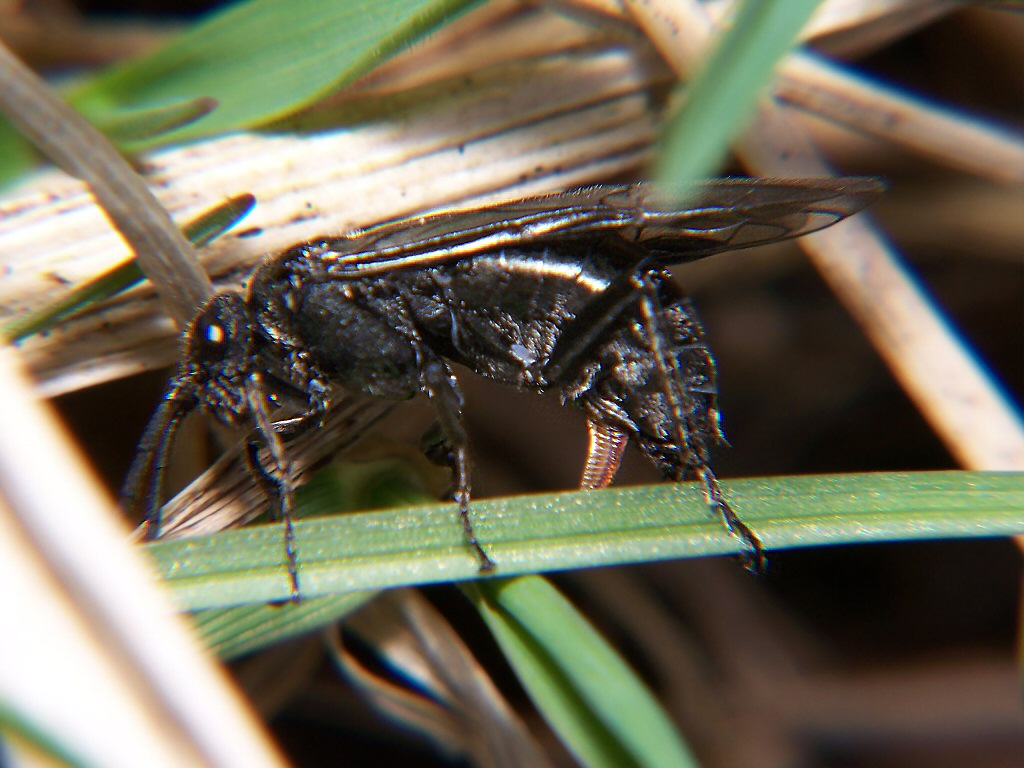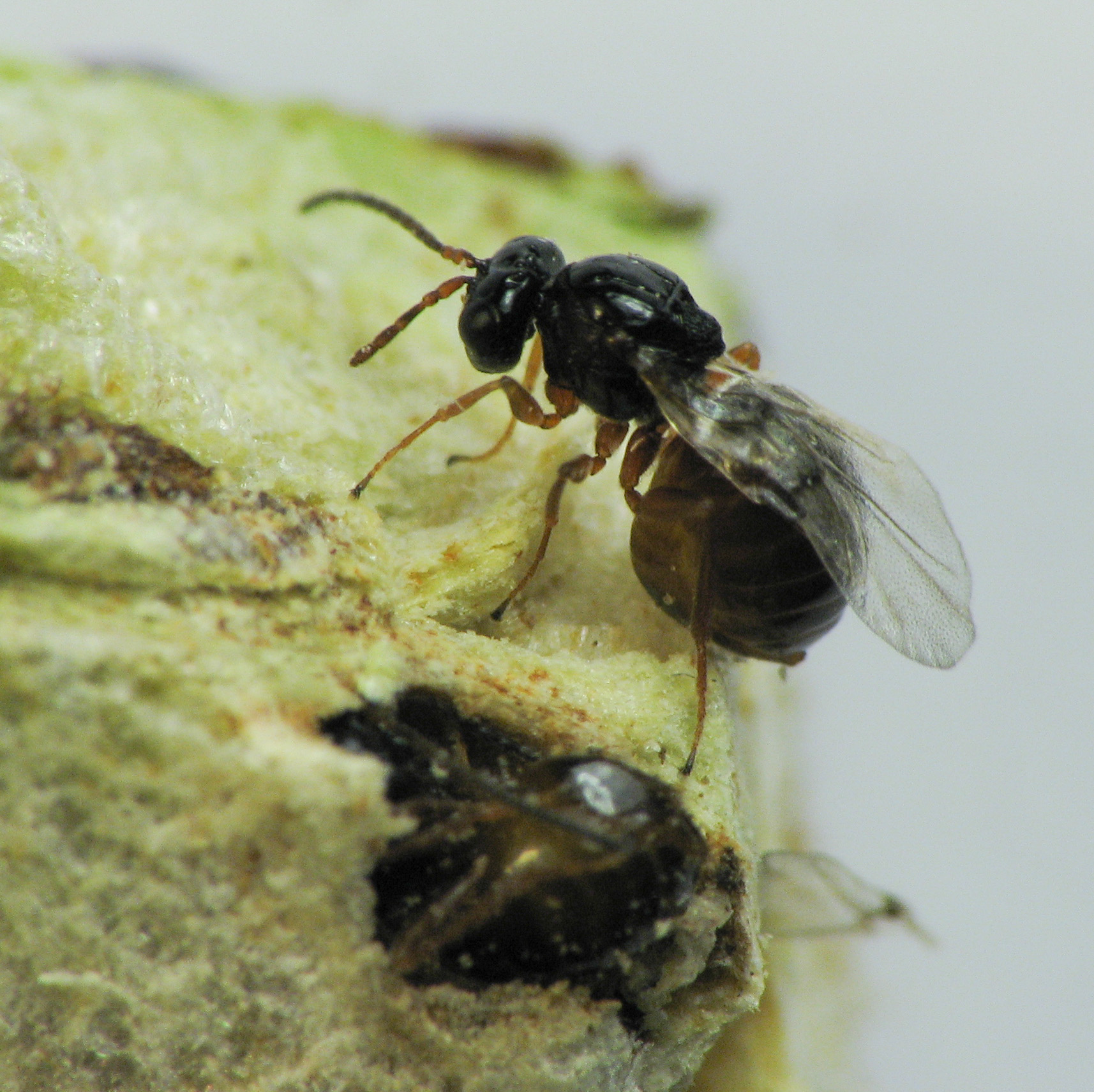|
Thelytoky
Thelytoky (from the Ancient Greek, Greek θῆλυς ''thēlys'' "female" and τόκος ''tókos'' "birth") is a type of parthenogenesis and is the absence of mating and subsequent production of all female diploid offspring as for example in aphids. Thelytokous parthenogenesis is rare among animals and reported in about 1,500 species, about 1 in 1000 of described animal species, according to a 1984 study. It is more common in invertebrates, like arthropods, but it can occur in vertebrates, including salamanders, fish, and reptiles such as some Cnemidophorus, whiptail lizards. Thelytoky can occur by different mechanisms, each of which has a different impact on the level of zygosity, homozygosity. It is found in several groups of Hymenoptera, including Apidae, Aphelinidae, Cynipidae, Formicidae, Ichneumonidae, and Tenthredinidae. It can be induced in Hymenoptera by the bacteria ''Wolbachia'' and ''Cardinium''. Advantages of thelytoky Species may encounter a few advantages employ ... [...More Info...] [...Related Items...] OR: [Wikipedia] [Google] [Baidu] |
Hymenoptera
Hymenoptera is a large order of insects, comprising the sawflies, wasps, bees, and ants. Over 150,000 living species of Hymenoptera have been described, in addition to over 2,000 extinct ones. Many of the species are parasitic. Females typically have a special ovipositor for inserting eggs into hosts or places that are otherwise inaccessible. This ovipositor is often modified into a stinger. The young develop through holometabolism (complete metamorphosis)—that is, they have a wormlike larval stage and an inactive pupal stage before they reach adulthood. Etymology The name Hymenoptera refers to the wings of the insects, but the original derivation is ambiguous. All references agree that the derivation involves the Ancient Greek πτερόν (''pteron'') for wing. The Ancient Greek ὑμήν (''hymen'') for membrane provides a plausible etymology for the term because species in this order have membranous wings. However, a key characteristic of this order is that the hi ... [...More Info...] [...Related Items...] OR: [Wikipedia] [Google] [Baidu] |
Wasp
A wasp is any insect of the narrow-waisted suborder Apocrita of the order Hymenoptera which is neither a bee nor an ant; this excludes the broad-waisted sawflies (Symphyta), which look somewhat like wasps, but are in a separate suborder. The wasps do not constitute a clade, a complete natural group with a single ancestor, as bees and ants are deeply nested within the wasps, having evolved from wasp ancestors. Wasps that are members of the clade Aculeata can sting their prey. The most commonly known wasps, such as yellowjackets and hornets, are in the family Vespidae and are eusocial, living together in a nest with an egg-laying queen and non-reproducing workers. Eusociality is favoured by the unusual haplodiploid system of sex determination in Hymenoptera, as it makes sisters exceptionally closely related to each other. However, the majority of wasp species are solitary, with each adult female living and breeding independently. Females typically have an oviposit ... [...More Info...] [...Related Items...] OR: [Wikipedia] [Google] [Baidu] |
Sawflies
Sawflies are wasp-like insects that are in the suborder Symphyta within the order Hymenoptera, alongside ants, bees, and wasps. The common name comes from the saw-like appearance of the ovipositor, which the females use to cut into the plants where they lay their eggs. The name is associated especially with the Tenthredinoidea, by far the largest superfamily in the suborder, with about 7,000 known species; in the entire suborder, there are 8,000 described species in more than 800 genera. Symphyta is paraphyletic, consisting of several basal groups within the order Hymenoptera, each one rooted inside the previous group, ending with the Apocrita which are not sawflies. The primary distinction between sawflies and the Apocrita – the ants, bees, and wasps – is that the adults lack a "wasp waist", and instead have a broad connection between the abdomen and the thorax. Some sawflies are Batesian mimics of wasps and bees, and the ovipositor can be mistaken for a stinger. S ... [...More Info...] [...Related Items...] OR: [Wikipedia] [Google] [Baidu] |
Haplodiploid Sex Determination In Honey Bees
Haplodiploidy is a sex-determination system in which males develop from unfertilized eggs and are haploid, and females develop from fertilized eggs and are diploid. Haplodiploidy is sometimes called arrhenotoky. Haplodiploidy determines the sex in all members of the insect orders Hymenoptera ( bees, ants, and wasps) and Thysanoptera ('thrips'). The system also occurs sporadically in some spider mites, Hemiptera, Coleoptera (bark beetles), and rotifers. In this system, sex is determined by the number of sets of chromosomes an individual receives. An offspring formed from the union of a sperm and an egg develops as a female, and an unfertilized egg develops as a male. This means that the males have half the number of chromosomes that a female has, and are haploid. The haplodiploid sex-determination system has a number of peculiarities. For example, a male has no father and cannot have sons, but he has a grandfather and can have grandsons. Additionally, if a eusocial-insect co ... [...More Info...] [...Related Items...] OR: [Wikipedia] [Google] [Baidu] |
Teiidae
Teiidae is a family of lacertoidean lizards native to the Americas. Members of this family are generally known as whiptails or racerunners; however, tegus also belong to this family. Teiidae is sister to the Gymnophthalmidae, Gymnopthalmidae, and both families comprise the Teiioidea. The Teiidae includes several Parthenogenesis, parthenogenic species – a mode of clonal reproduction. Presently, the Teiidae consists of approximately 150 species in eighteen genus, genera. Morphology and behavior Teiids can be distinguished from other lizards by the following characteristics: large rectangular scale (zoology), scales that form distinct transverse rows Anatomical terms of location#Dorsal and ventral, ventrally and generally small granular scale (zoology), scales Dorsum (anatomy), dorsally, head scales that are separate from the skull bones, and teeth that are solid at the base and "glued" to the jaw bones. Additionally, all teiids have a forked, snake-like tongue. They all possess we ... [...More Info...] [...Related Items...] OR: [Wikipedia] [Google] [Baidu] |
Cerapachys
''Cerapachys'' (common names include "raider ant" and "ant-raiding ant") is a genus of ants in the subfamily Dorylinae. Species are mainly myrmecophagous ants which raid the nests of other ants for prey. The genus is distributed widely throughout the Indomalaya The Indomalayan realm is one of the eight biogeographic realms. It extends across most of South and Southeast Asia and into the southern parts of East Asia. Also called the Oriental realm by biogeographers, Indomalaya spreads all over the Ind ...n region. The genus was revised by BoroWiec (2016) who split a number of previously synonymized genera out of ''Cerapachys'', leaving only 5 species in the genus. Species *'' Cerapachys anokha'' *'' Cerapachys antennatus'' *'' Cerapachys aranus'' *'' Cerapachys crawleyi'' *'' Cerapachys doryloides'' *'' Cerapachys edentatus'' *'' Cerapachys eguchii'' *'' Cerapachys iaianstewarti'' *'' Cerapachys incontentus'' *'' Cerapachys latus'' *'' Cerapachys lividus'' *' ... [...More Info...] [...Related Items...] OR: [Wikipedia] [Google] [Baidu] |
Gall Wasp
Gall wasps, also traditionally called gallflies, are hymenopterans of the family Cynipidae in the wasp superfamily Cynipoidea. Their common name comes from the galls they induce on plants for larval development. About 1,300 species of this generally very small creature () are known worldwide, with about 360 species of 36 different genera in Europe and some 800 species in North America. Features Like all Apocrita, gall wasps have a distinctive body shape, the so-called wasp waist. The first abdominal tergum (the propodeum) is conjoined with the thorax, while the second abdominal segment forms a sort of shaft, the petiole. The petiole connects with the gaster, which is the functional abdomen in apocritan wasps, starting with the third abdominal segment proper. Together, the petiole and the gaster form the metasoma, while the thorax and the propodeum make up the mesosoma. The antennae are straight and consist of two or three segments. In many varieties, the backside of the ... [...More Info...] [...Related Items...] OR: [Wikipedia] [Google] [Baidu] |
Smalltooth Sawfish
The smalltooth sawfish (''Pristis pectinata'') is a species of sawfish in the family (biology), family Pristidae. It is found in shallow tropical and subtropical waters in coastal and estuarine parts of the Atlantic. Reports from elsewhere are now believed to be misidentifications of other species of sawfish. It is a critically endangered species that has disappeared from much of its historical range. Distribution and habitat The smalltooth sawfish is found in tropical and subtropical parts of the Atlantic, including the Caribbean Sea, Caribbean and Gulf of Mexico. Its original range was the smallest of the sawfish species, covering about . In the west it once ranged from the United States to Uruguay and in the east from Senegal to Angola. Today it has disappeared from much of its historical range. There are old reports from the Mediterranean Sea, but this likely involved Vagrancy (biology), vagrants and according to the FAO the species can be considered locally extinct in the Med ... [...More Info...] [...Related Items...] OR: [Wikipedia] [Google] [Baidu] |
Genetics (journal)
''Genetics'' is a monthly scientific journal publishing investigations bearing on heredity, genetics, biochemistry and molecular biology Molecular biology is a branch of biology that seeks to understand the molecule, molecular basis of biological activity in and between Cell (biology), cells, including biomolecule, biomolecular synthesis, modification, mechanisms, and interactio .... Genetics is published by the Genetics Society of America. It has a delayed open access policy, and makes articles available online without a subscription after 12 months have elapsed since first publication. Since 2010, it is published online-only. George Harrison Shull was the founding editor of ''Genetics'' in 1916. Editors-in-Chief References Genetics journals Delayed open access journals English-language journals Academic journals established in 1916 Online-only journals {{genetics-journal-stub ... [...More Info...] [...Related Items...] OR: [Wikipedia] [Google] [Baidu] |
Cardinium
"''Candidatus'' Cardinium" is a genus of Gram-negative parasitic bacteria that reside within cells of some arthropods and nematodes. Although they have not yet been isolated in pure culture (hence the designation ''Candidatus''), they are known to negatively influence reproduction in their hosts in order to further their own proliferation. This leads to their classification as a reproductive parasite. One of the only other examples of this type of parasitism is the genus ''Wolbachia'', which also infects arthropods. These two genera can also co-infect the same animal, as in some nematodes. "''Candidatus'' Cardinium" bacteria use many of the same methods to interfere with host reproduction as ''Wolbachia,'' including inducing cytoplasmic incompatibility and distorting the sex ratio in the host population to favor females. The mechanisms by which "''Candidatus'' Cardinium" induces these conditions in hosts are thought to be different from the mechanisms used by ''Wolbachia''. "'' ... [...More Info...] [...Related Items...] OR: [Wikipedia] [Google] [Baidu] |




